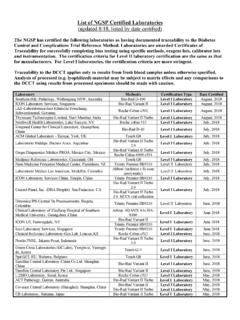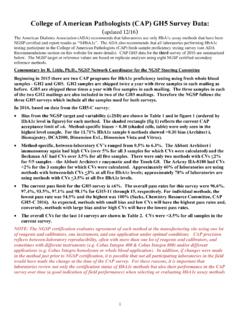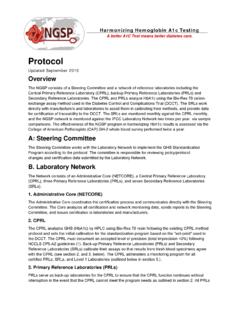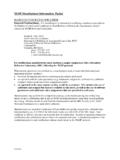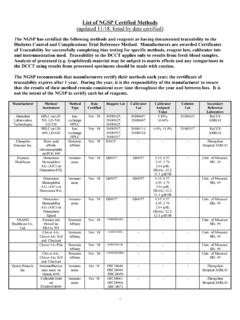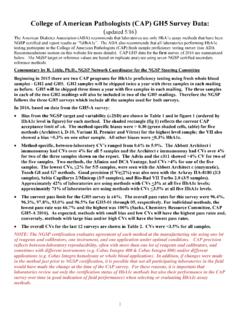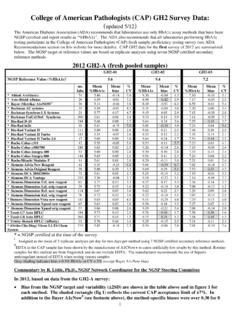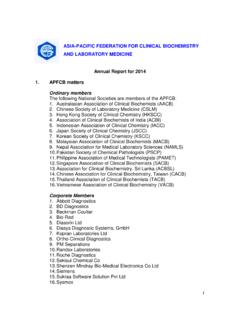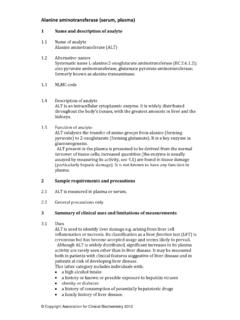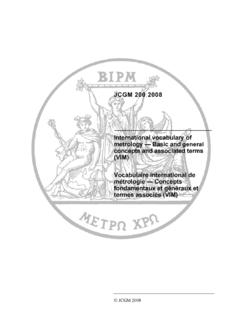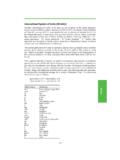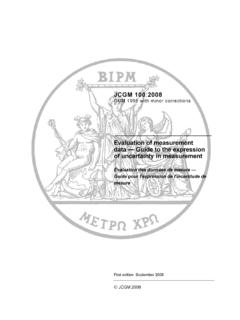Transcription of IFCC Std of HbA1c - NGSP Home
1 Harmonizing Hemoglobin A1c Testing A better A1C Test means better diabetes care. international federation of clinical chemistry ( ifcc ) Standardization of HbA1c Overview The international federation of clinical chemistry Working Group ( ifcc -WG) on HbA1c Standardization has developed reference methods for HbA1c analysis. They have established a laboratory network, which includes two reference methods, mass spectroscopy and capillary electrophoresis. Each network laboratory uses prepared mixtures of purified Hemoglobin A1c and HbA0 as calibrators. The relationship between HbA1c results from the NGSP network (% HbA1c ) and the ifcc network (mmol/mol) has been evaluated and a master equation has been developed (NGSP = [ * ifcc ] + ).
2 This relationship will continue to be monitored and any changes will be investigated. The NGSP certification process, and most important, test results for NGSP-certified methods will not change and will continue to be directly traceable to the DCCT reference and now also the ifcc reference. The ifcc Reference System ifcc Working Group: To achieve a uniform international standardization, the ifcc established a working group on HbA1c standardization in 1995. The WG ended in 2010 having fulfilled its mission. The Laboratory Network is now overseen by the ifcc Committee on Traceability in Laboratory Medicine (C-TLM).
3 The clinical and educational aspects of the group will be the responsibility of a new Integrated Project that has been formed by the ifcc . Definition of the Analyte: The ifcc working group has defined HbA1c as Hb that is irreversibly glycated at one or both N-terminal valines of the beta chains. This does not exclude hemoglobin that is additionally glycated at other sites on the alpha or beta chains. Primary Reference Material: For the calibration of the reference method, mixtures were made of pure HbA1c and pure HbA0. These fractions were isolated using cation exchange and affinity chromatography, and characterized using capillary isoelectric focusing, and electrospray ionization mass spectrometry.
4 Reference: Finke A., Kobold U, Hoelzel W, Weycamp C, Jeppsson JO, Miedema K. Preparation of a candidate primary reference material for the international standardisation of HbA1c determinations. Clin Chem Lab Med 1998; 36: 299-308 Reference Method: Two reference methods have been developed which specifically measure the glycated N-terminal residue of the beta-chain. The principle is that in a first step hemoglobin is cleaved into peptides by a proteolytic enzyme and thereafter the specific glycated and non-glycated N-terminal peptides of the beta-chain are measured by HPLC and either mass spectrometry or capillary electrophoresis.
5 These reference methods were approved by the ifcc in July 2001. ifcc Standardization of HbA1c Page 2 of 4 Reference: Jeppsson J-O, Kobold U, Barr J, Finke A, Hoelzel W, Hoshino T, Miedema K, Mauri P, Mosca A, Paroni R, Thienpont L, Umemoto M, Weykamp CW. Approved ifcc reference method for the measurement of HbA1c in human blood. Clin Chem Lab Med 2002; 40: 78-89 Implementation: An ifcc Laboratory Network has been established. The lists of current approved and candidate ifcc Network Laboratories can be found at: . Network laboratories participate in two intercomparison studies each year in order to renew their approval status according to the criteria of the network.
6 These studies are also used to evaluate the stability of calibrators and controls and to assess new batches of calibrator and control materials. Once each year 8 whole blood pools are prepared and shipped to network laboratories and participating manufacturers. The ifcc network assigns values to each level and manufacturers use them to calibrate their assay methods. Manufacturers can also subscribe to a monitoring program in which the ifcc provides samples on an ongoing basis (24 samples/year). References: Weykamp C, John WG, Mosca A, Hoshino T, Little R, Jeppsson J-O, Goodall I, Miedema K, Myers G, Reinauer H, Sacks DB, Slingerland R, and Siebelder C.
7 The ifcc Reference Measurement System for HbA1c : A 6-Year Progress Report. Clin Chem 2008; 54(2): 240-48 Konnert A, Berding C, Arends S, Parvin C, Rohlfing CL, Wiedmeyer H, Little R, Siebelder C, and Weykamp C. Statistical Rules for Laboratory Networks. J Testing & Evaluation 2006; 34(2): 1-7 Traceability and the EU Directive The EU directive states that "The traceability of values assigned to calibrators and/or control materials must be assured through available reference measurement procedures and/or available reference materials of a higher order". Therefore, for all products sold in Europe, manufacturers must make their products results "traceable" to the ifcc Reference Method.
8 Reference: Directive 98/79/EC of the European Parliament and of the Council of 27 October 1998 on in vitro diagnostic medical devices Official Journal of the European Communities 1998; 331:1 3 The ifcc and NGSP NGSP or ifcc Numbers: The Debate ifcc results are accuracy-based; NGSP results can be directly related to clinical outcomes and diabetes care goals. Although the ifcc /NGSP correlation is excellent, the absolute numbers are different and there has been much debate over which numbers should be reported worldwide. The relationship between the ifcc and NGSP (both in % HbA1c ) is shown in Figure 1.
9 ifcc results are consistently HbA1c lower throughout the range of values. The relationship between the NGSP network and ifcc networks was evaluated and a master equation was developed to document this Figure 1 2345678910111224681012 NGSP (% HbA1c ) ifcc (% HbA1c )NNGSP = ( * ifcc ) + Standardization of HbA1c Page 3 of 4 relationship (NGSP = [ * ifcc ] + ). In 2007, the ifcc recommended that ifcc HbA1c be expressed as mmol HbA1c /mol Hb. With these new units, the master equation changes to NGSP = [ * ifcc ] + ). This change in units avoids any confusion between NGSP and ifcc results.
10 The master equation links ifcc results to clinically meaningful HbA1c results from the Diabetes Control and Complications Trial (DCCT) and the United Kingdom Prospective Diabetes Study (UKPDS). It also provides the NGSP with traceability to a higher order reference method. In 2004, the ADA/EASD/IDF Working Group of the A1c Assay was established to harmonize HbA1c reporting. The advantages and disadvantages of reporting HbA1c results in the new ifcc range vs. maintaining current NGSP/DCCT/UKPDS values, as well as reporting HbA1c as mean blood glucose, were discussed.
